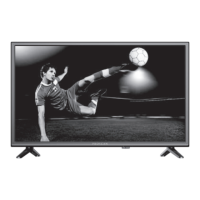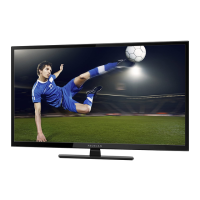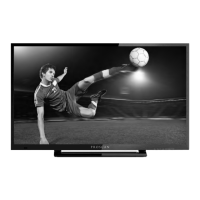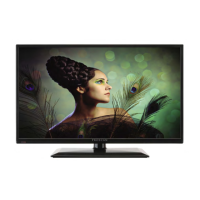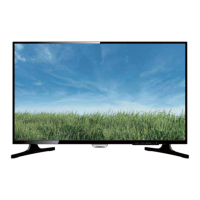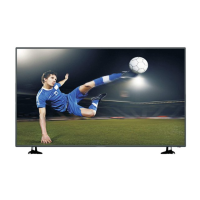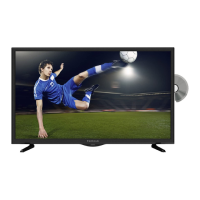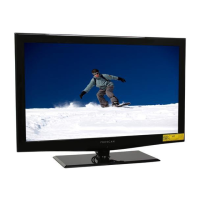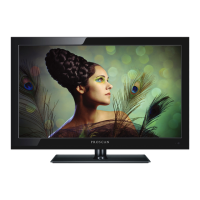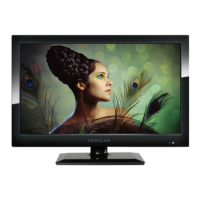Do you have a question about the ProScan PLDED4022-UK and is the answer not in the manual?
Important safety advice and cautionary symbols related to the product.
Warnings about electrical shock risks and proper handling procedures.
Advice on positioning the unit and ensuring adequate ventilation.
Identifies the location of the unit's essential rating plate.
Information regarding HDMI logos and registered trademarks.
A detailed list of 15 essential safety instructions for user operation.
Lists all items supplied with the television unit.
Guidance on how to effectively use the remote control.
Instructions for remote battery installation and replacement procedures.
Detailed explanation of remote buttons specific to ATV mode.
Detailed explanation of remote buttons specific to DTV mode.
Explains common remote functions like MENU, SOURCE, and VOLUME.
Labels and explains components visible on the TV's front panel.
Identifies and explains rear panel input and output ports.
Explains the purpose of each button located on the TV's side.
How to connect TV broadcast sources like antennas and satellite systems.
Connecting video sources like VCRs, game systems, or camcorders.
Connecting HD devices using component video inputs.
Connecting HD devices using HDMI inputs for high-quality audio/video.
How to connect a computer to the TV via VGA and audio cables.
Connecting headphones for private listening without speaker output.
Proper installation and safety precautions for the power cord.
Setup for optimal audio performance with home theater systems.
Guide to configuring the SPDIF digital audio output for surround sound.
Steps for attaching or detaching the TV's base stand.
Instructions for safely mounting the TV on a wall using VESA standards.
Recommendations for TV placement to ensure safety and ventilation.
Steps for turning on the TV for the first time and initial setup.
How to choose the active input source for viewing content.
Accessing and using the channel menu options for TV setup.
How to automatically search for and tune available channels.
Procedure for manually tuning specific channels.
Detailed steps for digital manual channel tuning.
Detailed steps for analog manual channel tuning.
Options to delete, skip, or reorder channels.
Settings for using a Conditional Access Module (CAM) for pay TV.
Viewing broadcast signal strength and quality information.
Choosing preferred visual display modes like Standard, Mild, or Dynamic.
Adjusting picture clarity, contrast levels, and detail in dark areas.
Fine-tuning color vibrancy, hue, and overall color warmth.
Changing screen format and enabling noise reduction or dynamic contrast.
Selecting sound profiles and adjusting audio equalization settings.
Adjusting audio frequencies and stereo balance.
Enhancing spatial audio effects and managing automatic volume leveling.
Configuring the digital audio output signal for external systems.
Adjusting the audio description feature for accessibility.
Choosing between Stereo, Dual, or Mixed audio types.
Navigating the menu for parental controls and channel locking features.
Setting passwords and enabling locking functions for security.
Restricting channel access and content ratings.
Settings for hotel or commercial installations.
Options for setting new passwords or clearing existing locks.
Accessing and navigating the general setup menu options.
Changing on-screen display and audio languages.
Setting up subtitle display options and languages.
Configuring teletext display and language preferences.
Adjusting clock, timers, time zone, and OSD display duration.
Configuring Personal Video Recorder functions and checking USB devices.
Guided setup process for new users.
Restoring factory default configurations for the TV.
Accessing the PC input setup options.
Using the auto-adjust feature for optimal PC input display.
Fine-tuning H/V position, phase, and clock for PC input.
Steps to plug in and select a USB source for media playback.
How to browse and view photo files from a USB storage device.
Playing audio files from a USB storage device.
Playing video files from a USB storage device.
How to display text files from a USB storage device.
Table of compatible PC resolutions and scan frequencies.
Important considerations for PC display compatibility.
Table of compatible video resolutions and formats.
Important considerations for video input compatibility.
Details on display panel, resolution, color system, and audio.
Information on connectivity jacks and power requirements.
Note that specifications may change without prior notice.
Solutions for snow, distortion, blurriness, and color issues.
Resolving no sound or channel selection problems.
Addressing issues like panel response, heat, and dots.
Solutions for screen stripes and power-on display errors.
Important safety advice and cautionary symbols related to the product.
Warnings about electrical shock risks and proper handling procedures.
Advice on positioning the unit and ensuring adequate ventilation.
Identifies the location of the unit's essential rating plate.
Information regarding HDMI logos and registered trademarks.
A detailed list of 15 essential safety instructions for user operation.
Lists all items supplied with the television unit.
Guidance on how to effectively use the remote control.
Instructions for remote battery installation and replacement procedures.
Detailed explanation of remote buttons specific to ATV mode.
Detailed explanation of remote buttons specific to DTV mode.
Explains common remote functions like MENU, SOURCE, and VOLUME.
Labels and explains components visible on the TV's front panel.
Identifies and explains rear panel input and output ports.
Explains the purpose of each button located on the TV's side.
How to connect TV broadcast sources like antennas and satellite systems.
Connecting video sources like VCRs, game systems, or camcorders.
Connecting HD devices using component video inputs.
Connecting HD devices using HDMI inputs for high-quality audio/video.
How to connect a computer to the TV via VGA and audio cables.
Connecting headphones for private listening without speaker output.
Proper installation and safety precautions for the power cord.
Setup for optimal audio performance with home theater systems.
Guide to configuring the SPDIF digital audio output for surround sound.
Steps for attaching or detaching the TV's base stand.
Instructions for safely mounting the TV on a wall using VESA standards.
Recommendations for TV placement to ensure safety and ventilation.
Steps for turning on the TV for the first time and initial setup.
How to choose the active input source for viewing content.
Accessing and using the channel menu options for TV setup.
How to automatically search for and tune available channels.
Procedure for manually tuning specific channels.
Detailed steps for digital manual channel tuning.
Detailed steps for analog manual channel tuning.
Options to delete, skip, or reorder channels.
Settings for using a Conditional Access Module (CAM) for pay TV.
Viewing broadcast signal strength and quality information.
Choosing preferred visual display modes like Standard, Mild, or Dynamic.
Adjusting picture clarity, contrast levels, and detail in dark areas.
Fine-tuning color vibrancy, hue, and overall color warmth.
Changing screen format and enabling noise reduction or dynamic contrast.
Selecting sound profiles and adjusting audio equalization settings.
Adjusting audio frequencies and stereo balance.
Enhancing spatial audio effects and managing automatic volume leveling.
Configuring the digital audio output signal for external systems.
Adjusting the audio description feature for accessibility.
Choosing between Stereo, Dual, or Mixed audio types.
Navigating the menu for parental controls and channel locking features.
Setting passwords and enabling locking functions for security.
Restricting channel access and content ratings.
Settings for hotel or commercial installations.
Options for setting new passwords or clearing existing locks.
Accessing and navigating the general setup menu options.
Changing on-screen display and audio languages.
Setting up subtitle display options and languages.
Configuring teletext display and language preferences.
Adjusting clock, timers, time zone, and OSD display duration.
Configuring Personal Video Recorder functions and checking USB devices.
Guided setup process for new users.
Restoring factory default configurations for the TV.
Accessing the PC input setup options.
Using the auto-adjust feature for optimal PC input display.
Fine-tuning H/V position, phase, and clock for PC input.
Steps to plug in and select a USB source for media playback.
How to browse and view photo files from a USB storage device.
Playing audio files from a USB storage device.
Playing video files from a USB storage device.
How to display text files from a USB storage device.
Table of compatible PC resolutions and scan frequencies.
Important considerations for PC display compatibility.
Table of compatible video resolutions and formats.
Important considerations for video input compatibility.
Details on display panel, resolution, color system, and audio.
Information on connectivity jacks and power requirements.
Note that specifications may change without prior notice.
Solutions for snow, distortion, blurriness, and color issues.
Resolving no sound or channel selection problems.
Addressing issues like panel response, heat, and dots.
Solutions for screen stripes and power-on display errors.
| Screen Size | 40 inches |
|---|---|
| Display Technology | LED |
| Maximum Resolution | 1920 x 1080 |
| HDMI Ports | 2 |
| USB Ports | 1 |
| Refresh Rate | 60 Hz |
| Smart TV | No |
| Built-in Tuner | Yes |
| Resolution | 1920 x 1080 |
